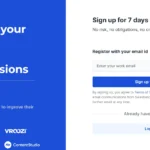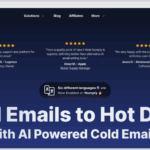Saleshandy vs Woodpecker: Which is Better for Outreach?

Saleshandy vs Woodpecker: Which is Better for Outreach?
In the ever-evolving landscape of digital marketing and sales outreach, the tools you choose can significantly impact your success. Two popular platforms that have emerged as frontrunners in this domain are Saleshandy and Woodpecker. Both tools offer unique features designed to enhance email outreach, but they cater to different needs and preferences. In this article, we will delve into a detailed comparison of these two platforms, examining their features, usability, and overall effectiveness in outreach campaigns. By the end of this analysis, you will have a clearer understanding of which tool might be the best fit for your specific outreach needs.
Introduction
Outreach is a critical component of any sales strategy, and the right tools can make all the difference in achieving your goals. As businesses increasingly rely on email communication to connect with potential clients, the demand for effective outreach tools has surged. This is where Saleshandy vs Woodpecker comes into play. Both platforms offer a range of functionalities aimed at improving email outreach, but they do so in different ways. Understanding the strengths and weaknesses of each tool is essential for making an informed decision. In this article, we will explore the features of Saleshandy and Woodpecker, providing a comprehensive overview of what each platform has to offer.
Saleshandy Overview
Saleshandy is a versatile email outreach tool that focuses on enhancing user engagement through its robust tracking and writing features. It is designed to help users create, send, and monitor their email campaigns effectively. One of the standout features of Saleshandy is its email tracking capability, which provides real-time notifications when recipients open emails or click on links. This feature allows users to gauge the effectiveness of their outreach efforts and follow up promptly with interested leads. Additionally, Saleshandy offers a variety of email templates and a built-in writing assistant, making it easier for users to craft compelling emails that resonate with their audience.
Related Topic:Email Tracking and Engagement Features
The email tracking functionality of Saleshandy is one of its most significant advantages. Users receive instant notifications when their emails are opened or when links within the emails are clicked. This real-time feedback is invaluable for sales professionals who need to act quickly on interested leads. By knowing when a recipient has engaged with their email, users can tailor their follow-up strategies accordingly, increasing the likelihood of conversion. Furthermore, Saleshandy provides detailed analytics on email performance, allowing users to assess which messages are resonating with their audience and which may need adjustments.
Email Templates and Writing Assistance
Another key feature of Saleshandy is its extensive library of email templates. These templates are designed to cater to various outreach scenarios, from cold emails to follow-ups. Users can easily customize these templates to suit their specific needs, saving time and ensuring consistency in their messaging. Additionally, Saleshandy includes a writing assistant that offers suggestions and guidance on crafting effective emails. This feature is particularly beneficial for users who may struggle with writing or who are new to email outreach. By providing tips on tone, structure, and content, the writing assistant helps users create professional and engaging emails that are more likely to elicit positive responses.
Woodpecker Overview
Woodpecker, on the other hand, is primarily focused on automating outreach campaigns and managing follow-ups. It is designed for sales teams that need to reach a large audience efficiently while maintaining a level of personalization in their communications. Woodpecker excels in its ability to send personalized emails at scale, making it a popular choice for businesses looking to streamline their outreach processes. However, it is essential to note that Woodpecker does not offer the same level of writing assistance or template availability as Saleshandy, which may pose challenges for some users.
Related Topic: Saleshandy: What It Is and How It Works Explained
Saleshandy: What It Is and How It Works ExplainedAutomating Outreach Campaigns
One of the standout features of Woodpecker is its automation capabilities. Users can set up automated email sequences that are triggered based on specific actions or timelines. This means that once a campaign is launched, Woodpecker can handle follow-ups and reminders without requiring constant manual input from the user. This level of automation is particularly beneficial for sales teams that need to manage a high volume of leads and outreach efforts. By automating repetitive tasks, Woodpecker allows users to focus on more strategic aspects of their outreach, such as refining their messaging and building relationships with potential clients.
Personalization at Scale
Woodpecker also emphasizes personalization, allowing users to customize their outreach messages for each recipient. This is achieved through the use of placeholders that can be filled with specific information about the recipient, such as their name, company, or other relevant details. This level of personalization is crucial for effective outreach, as it helps to establish a connection with the recipient and increases the likelihood of engagement. However, it is important to note that while Woodpecker excels in automation and personalization, it lacks the writing assistance and template features that Saleshandy offers. This absence may leave some users feeling uncertain about the quality of their emails, particularly if they are not confident in their writing skills.
Comparative Analysis
When comparing Saleshandy and Woodpecker, it is essential to consider various factors that can influence your decision. Both tools have their strengths and weaknesses, and the best choice will depend on your specific outreach needs and preferences. Below, we will conduct a comparative analysis of the key features offered by each platform, providing a clearer picture of how they stack up against each other in the context of outreach.
Related Topic: Saleshandy vs Instantly vs Nureply: Key Differences Explained
Saleshandy vs Instantly vs Nureply: Key Differences ExplainedFeature Comparison
| Feature | Saleshandy | Woodpecker |
|---|---|---|
| Email Tracking | Yes | No |
| Email Templates | Yes | No |
| Writing Assistance | Yes | No |
| Automation | No | Yes |
| User Experience | User-friendly | Steeper learning curve |
As illustrated in the table above, there are several key differences between Saleshandy and Woodpecker. Saleshandy offers robust email tracking, templates, and writing assistance, making it an excellent choice for users who prioritize these features. In contrast, Woodpecker excels in automation and personalization, making it ideal for sales teams looking to streamline their outreach efforts. However, the lack of writing support and templates in Woodpecker may be a drawback for some users, particularly those who are new to email outreach or who prefer a more structured approach.
Conclusion
In conclusion, the choice between Saleshandy vs Woodpecker ultimately depends on your specific outreach needs and preferences. If you value email tracking, writing assistance, and a user-friendly interface, Saleshandy may be the better option for you. Its comprehensive features are designed to enhance user engagement and streamline the email creation process, making it an excellent choice for individuals and teams looking to improve their outreach efforts. On the other hand, if your primary goal is to automate outreach campaigns and manage follow-ups efficiently, Woodpecker could be more advantageous. Its automation capabilities and focus on personalization make it a strong contender for sales teams aiming to reach a larger audience effectively. Each tool has its strengths and weaknesses, and the best choice will vary based on individual preferences and requirements. By carefully considering your outreach goals and the features offered by each platform, you can make an informed decision that aligns with your needs.
If you want to discover other articles similar to Saleshandy vs Woodpecker: Which is Better for Outreach?, you can visit the Email Marketing category.

Related Posts: